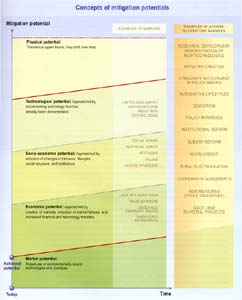Adoption of opportunities including greenhouse
gas-reducing technologies and measures may require overcoming barriers
through the implementation of policy measures.
| Table 7-2: Estimates of potential global greenhouse gas emission reductions in the year 2010: land use, land-use change, and forestry. | |||
| Categories of Mitigation Options | Potential Emission Reductions in 2010 [Mt C yr-1] |
Potential Emission Reductions [Mt C] |
|
| Afforestation/reforestation (AR)a | 197-584 | Includes carbon in above- and below-ground biomass. Excludes carbon in soils and in dead organic matter. | |
| Reducing deforestation (D)b | 1,788 | Potential for reducing deforestation is very uncertain for the tropics and could be in error by as much as ±50%. | |
| Improved management within a land use (IM)c | 570 | Assumed to be the best available suite of management practices for each land use and climatic zone. | |
| Land-use change (LC)c | 435 | ||
| Total | 1,202-1,589 | 1,788 | |
| a. Source: SRLULUCF
Table SPM-3. Based on IPCC definitional scenario. Information
is not available for other definitional scenarios. Potential refers
to the estimated range of accounted average stock change for the period
2008-2012 (Mt C yr-1). b. Source: SRLULUCF Table SPM-3. Based on IPCC definitional scenario. Information is not available for other definitional scenarios. Potential refers to the estimated average stock change (Mt C). c. Source: SRLULUCF Table SPM-4. Potential refers to the estimated net change in carbon stocks in the year 2010 (Mt C yr-1). The list of activities is not exclusive or complete, and it is unlikely that all countries will apply all activities. Some of these estimates reflect considerable uncertainty. |
|||
The successful implementation of greenhouse gas mitigation
options would need to overcome technical, economic, political, cultural,
social, behavioral, and/or institutional barriers that prevent the full
exploitation of the technological, economic, and social opportunities
of these mitigation options (see Figure
7-1). The potential mitigation opportunities and types of barriers
vary by region and sector, and over time. Most countries could benefit
from innovative financing, social learning and innovation, and institutional
reforms, removing barriers to trade, and poverty eradication. This is
caused by a wide variation in mitigation capacity. The poor in any country
are faced with limited opportunities to adopt technologies or change their
social behavior, particularly if they are not part of a cash economy.
Most countries could benefit from innovative financing and institutional
reform and removing barriers to trade. In the industrialized countries,
future opportunities lie primarily in removing social and behavioral barriers;
in countries with economies in transition, in price rationalization; and
in developing countries, in price rationalization, increased access to
data and information, availability of advanced technologies, financial
resources, and training and capacity building. Opportunities for any given
country, however, might be found in the removal of any combination of
barriers.
National responses to climate change
can be more effective if deployed as a portfolio of policy instruments
to limit or reduce net greenhouse gas emissions. The portfolio
of national climate policy instruments may include -- according to national
circumstances -- emissions/carbon/energy taxes, tradable or non-tradable
permits, provision and/or removal of subsidies, land-use policies, deposit/refund
systems, technology or performance standards, energy mix requirements,
product bans, voluntary agreements, information campaigns, environmental
labeling, government spending and investment, and support for research
and development (R&D). The literature in general gives no preference
for any particular policy instrument.
 |